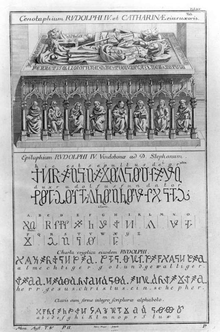Rudolf IV, Duke of Austria

Rudolf IV der Stifter (the Founder) (November 1 1339 – July 27 1365) was a member of the House of Habsburg and Duke (self-proclaimed Archduke) of Austria from 1358 to 1365. Gave order to write the "Privilegium Maius" a fake document to empower the ruler aof Austria.
Biography
Born in Vienna, Rudolf was the eldest son of Albert II and Johanna von Pfirt. One of the third generation of Habsburg dukes in Austria, he was the first to be born in Austria. Therefore, he considered Austria his home, a sentiment that no doubt communicated itself to his subjects and contributed to his popularity. He was one of the most energetic and active rulers of Austria in the late Middle Ages, and it was said of him that as a young man he already had the air of a king.
He was married to Katharine of Bohemia the daughter of Emperor Charles IV. Eager to compete with his father-in-law, who had made Prague a radiant center of culture, Rudolf desired to raise the importance of Vienna to a comparable or greater height.
For more than a century, the Habsburg dukes had chafed at the Popes' failure to make Vienna the seat of its own diocese, a status that they considered appropriate for the seat of a duchy. The Bishops of Passau, the diocese that included Vienna, had excellent connections to the Pope, apparently dooming Vienna's prospects in this regard. Rudolf, however, resorted to something which could be considered imposture: He initiated the creation in the Cathedral of Saint Stephan (Stephansdom) of a Metropolitan Chapter (which, according to the name, should be assigned to a bishop), whose members wore red garments as cardinals do. The provost of the chapter received the title of Arch-Chancellor of Austria.

Rodolf extended Stephansdom, with the construction of its gothic nave being started under Rudolf's rule. Rudolf had himself be depicted on the cathedral's entrance. The construction efforts can be seen as an attempt to compete with St. Vitus Cathedral in Prague.
Similarly, by founding the University of Vienna in 1365, Rudolf sought to match Charles IV's founding of the Charles University of Prague in 1348. Still known as Alma Mater Rudolphina today, the University of Vienna is the oldest continuously operating university in the German-speaking world. However, a faculty of theology, which was considered crucial for a university at that time, was not established until 1385, twenty years after Rudolf's death.
To improve the economy of Vienna Rudolf introduced many other measures, including the supervision by the mayor of sales of real property, instituted to prevent sales to the dead hand, i.e., to prevent economically unproductive ownership by the Church. Rudolf also managed to establish a relatively stable currency, the so-called Wiener Pfennig (Vienna Penny).
Rudolf is best known for another bluff, the forgery of the Privilegium Maius, which de facto put him on par with the Electors of the Holy Roman Empire, compensating for Austria's failure to receive an electoral vote in the Golden Bull. The title of Archduke, invented by Rudolf, became an honorific title of all males of the House of Habsburg in the 16th century.
In 1363, Rudolf entered into a contract of inheritance with Countess Margarete Maultasch of the Tyrol, which brought the Tyrol under Austrian rule only after her death in 1369 since her brother-in-law Stephen II, Duke of Bavaria had invaded the country. The next year, he concluded another Contract of Inheritance with his father-in-law Emperor Charles, providing for mutual inheritance between the Habsburgs and Luxemburg.
In spite of the high-flying (and maybe sometimes megalomaniac) character of his plans, he managed to modernize his territories and his city, the prominence of which considerably increased. His untimely death halted further progress, however. His brothers Albert III and Leopold III, who were to rule jointly under the Rudolfinische Hausordnung (Rudolfinian House Rules), began to quarrel ceaselessly and ultimately agreed to divide the Habsburg territories between them in 1379.
Rudolf is also remembered for founding Novo Mesto in Slovenia whose German name, Rudolfswert, was given in his honor.
Rudolf died in Milan in 1365. He and his wife are buried in the Ducal Crypt in the Stephansdom in Vienna.
References
- Baum, Wilhelm (1996). Rudolf IV. der Stifter. Seine Welt und seine Zeit. Graz-Wien-Köln.
External links
